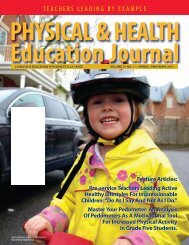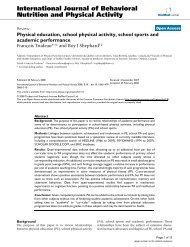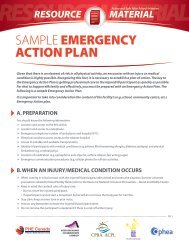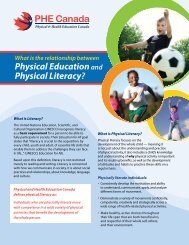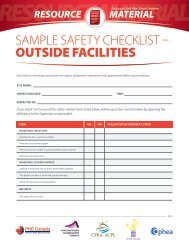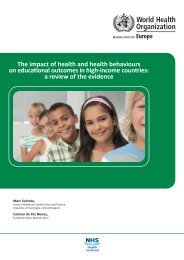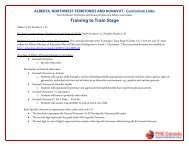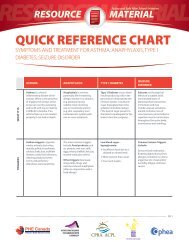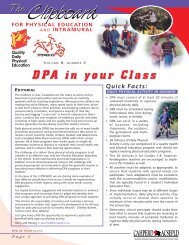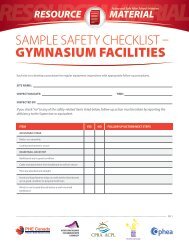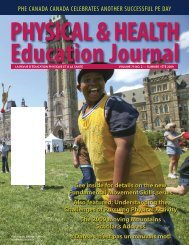PDF (English) - PHE Canada
PDF (English) - PHE Canada
PDF (English) - PHE Canada
Create successful ePaper yourself
Turn your PDF publications into a flip-book with our unique Google optimized e-Paper software.
Males and Females Ages 0-6<br />
QUEBEC - Curriculum Links<br />
Active Start Stage<br />
Grades Corresponding to Active Start Stage of LTAD:<br />
Kindergarten and Grade 1.<br />
Provincial Curriculum Document Grade Organization: The curricula relevant to the Active Start stage (Kindergarten and Grade 1) exists within<br />
the Quebec Ministry of Education document Quebec Education Program: Progression of Learning: Physical Education and Health (2009). This<br />
curriculum document is available at: http://www.mels.gouv.qc.ca/progression/educationPhysique/pdf/edPhy_en_sectionCom.pdf<br />
Structure Quebec’s Physical Education Curriculum:<br />
The curriculum is organized into Competencies, and then further organized by sub-headings:<br />
Competency 1 – To perform movement skills in different physical activity settings<br />
Knowledge<br />
Motor Skills<br />
Competency 2 – To interact with others in different physical activity settings<br />
Knowledge<br />
Strategies (action rules)<br />
Motor Skills<br />
Behaviour<br />
Competency 3 – To adopt a healthy, active lifestyle<br />
Knowledge (lifestyle habits)<br />
Knowledge (effects of a sedentary lifestyle)<br />
Knowledge (anatomy and physiology of the human body)<br />
Within these subheadings the specific knowledge, skills, strategies and behaviours are listed.
QUEBEC - Curriculum Links<br />
Note: The Quebec Education Program outlines the achievement of competencies in Cycles, which represent Grades. The Cycles represent the<br />
following grades:<br />
• Elementary (Grades 1-6)<br />
o Cycle 1 = Grades 1 (Cycle 1.1) and 2 (Cycle 1.2)<br />
o Cycle 2 = Grades 3 (Cycle 2.1) and 4 (Cycle 2.2)<br />
o Cycle 3 = Grades 5 (Cycle 3.1) and 6 (Cycle 3.2)<br />
• Secondary (Grades 7-11)<br />
o Cycle 1 = Grades 7 (Cycle 1.1) and 8 (Cycle 1.2)<br />
o Cycle 2 = Grades 9 (Cycle 2.1), 10 (Cycle 2.2) and 11 (Cycle 2.3)<br />
Student constructs knowledge with teacher guidance.<br />
* Student applies knowledge by the end of the school year.
Kindergarten and Grade 1 (Elementary Cycle 1):<br />
QUEBEC - Curriculum Links<br />
Component of Active Start Stage Linking General and Specific Outcomes<br />
FUN and part of daily life<br />
Fitness and movement skills development Competency 1<br />
Motor Skills<br />
A. Locomotor Skills<br />
1. Moving about an area with and without obstacles<br />
* a. Walks, crawls, skips, moves on all fours<br />
b. Runs, gallops, hops, performs standing long<br />
c. Goes around and through obstacles (e.g. goes around cones, through a tunnel)<br />
d. Performs side steps and cross-steps, spins<br />
e. Goes over obstacles (e.g. jumps over hurdles)<br />
2. Moving about on apparatus<br />
a. Moves through low apparatus (e.g. walks along an overturned balance bench)<br />
b. Moves through apparatus of various heights (e.g. moves along a horizontal<br />
ladder, goes up a climbing wall)<br />
c. Climbs apparatus of various heights (e.g. goes up and down wall bars, climbs a<br />
rope)<br />
3. Moving about using objects<br />
a. Moves about using different objects (e.g. skates, skis, rolls a cylinder by walking<br />
on it)<br />
4. Running jumps<br />
a. Performs different running jumps(e.g. broad jump, high jump, half twist)<br />
5. Jumping rope<br />
a. Jumps rope (basic jump)<br />
b. Jumps rope in different ways(e.g. on one foot, backwards, while moving, with<br />
feet crossed)<br />
6. Floor rotations<br />
a. Performs a tuck forward roll<br />
b. Rolls in different ways (e.g. forward straddle roll)
QUEBEC - Curriculum Links<br />
B. Nonlocomotor Skills<br />
1. Balanced stances (postures) on the floor and on apparatus<br />
a. Maintains simple postures using different body parts for support (e.g. stork<br />
stand, arabesque on one knee)<br />
b. Maintains simple postures on apparatus (e.g. stork stand on balance bench,<br />
squatting on a fixed cylinder).<br />
2. Rotations on the spot and on apparatus<br />
a. Turns on his/her own axis on the floor (e.g. pivots on one foot, spins).<br />
C. Manipulation Skills<br />
1. Object manipulation<br />
a. Handles a variety of objects in different ways (e.g. moves a ball around his/her<br />
body, rolls a hoop)<br />
b. Handles a variety of objects used in specialized activities (e.g. circus arts,<br />
rhythmic gymnastics)<br />
c. Dribbles with one hand<br />
i. on the spot and while moving<br />
ii. through obstacles (e.g. dribbles a ball between cones)<br />
d. Dribbles with feet<br />
i. on the spot and while moving<br />
e. Juggles different patterns, using<br />
i. one object<br />
ii. two objects<br />
f. Juggles different patterns while moving, using<br />
i. one object<br />
2. Projecting objects without an implement<br />
a. Throws a variety of objects underhand at a target (e.g. throws a beanbag into a<br />
container, throws a ball at a bowling pin)<br />
b. Throws a variety of objects overhand at a target (e.g. throws a ball at a target on<br />
the wall)<br />
c. Strikes or kicks a variety of objects at a target (e.g. kicks a ball toward a bowling
QUEBEC - Curriculum Links<br />
pin)<br />
4. Receiving objects with or without an implement<br />
* a. Catches a variety of objects using two hands (e.g. catches a ball after throwing it<br />
against a wall)<br />
b. Catches a variety of objects using one hand (e.g. catches a ball after one bounce<br />
on the floor)<br />
c. Catches an object using his/her foot in different ways (e.g. deflects, blocks, traps<br />
or controls).<br />
Competency 2<br />
Motor Skills<br />
A. Cooperation movements or actions<br />
1. Cooperates with partner(s) while performing movements or actions in the right place at<br />
the right time<br />
a. Throws an object at a moving target (e.g. passes a ball to a partner who is<br />
moving)<br />
b. Receives an object while moving (e.g. catches a Frisbee thrown by a partner).<br />
2. Synchronizes his/her movements or actions with partner(s)<br />
a. Adapts his/her actions to those of a partner according to different<br />
synchronization modes (e.g. simultaneous, successive) (e.g. dribbles a ball at the<br />
same pace as a partner)<br />
c. Positions himself/herself, moves or manipulates objects taking into account<br />
his/her partner(s) (e.g. creates a human pyramid, juggles with a partner)<br />
B. Opposition movements or actions<br />
2. Opposition movements or actions in dueling activities in a common space (e.g. tag and<br />
chase games)<br />
a. Gets away from the opponent (e.g. runs quickly away from the opponent)<br />
b. Reaches the opponent (e.g. touches the opponent in a game of tag or in foam<br />
fencing)<br />
c. Dodges an attack by the opponent (e.g. moves at the right time in order not to
Focus on learning proper movement skills such as<br />
running, jumping, wheeling, twisting, kicking,<br />
throwing, and catching<br />
QUEBEC - Curriculum Links<br />
lose his/her flag)<br />
d. Deceives the opponent using a feint (e.g. changes direction or speed in a game<br />
of one-on-one)<br />
Competency 3<br />
Knowledge (lifestyle habits)<br />
D. Physical fitness (influencing factors)<br />
1. Flexibility<br />
a. Explains in his/her own words the importance of stretching (e.g. to increase the<br />
range and ease of motion of a muscle, prevent and relieve muscle soreness)<br />
b. Performs stretching exercises (e.g. stretches arm, thigh muscles)<br />
2. Posture<br />
a. Adopts proper posture while sitting on the floor and while standing (e.g. sitting<br />
cross-legged)<br />
Competency 1<br />
Motor Skills<br />
A. Locomotor Skills<br />
1. Moving about an area with and without obstacles<br />
* a. Walks, crawls, skips, moves on all fours<br />
b. Runs, gallops, hops, performs standing long<br />
4. Running jumps<br />
a. Performs different running jumps(e.g. broad jump, high jump, half twist)<br />
B. Nonlocomotor Skills<br />
1. Balanced stances (postures) on the floor and on apparatus<br />
a. Maintains simple postures using different body parts for support (e.g. stork<br />
stand, arabesque on one knee)<br />
b. Maintains simple postures on apparatus (e.g. stork stand on balance bench,<br />
squatting on a fixed cylinder).<br />
2. Rotations on the spot and on apparatus<br />
a. Turns on his/her own axis on the floor (e.g. pivots on one foot, spins).
Not sedentary for more than 60 minutes except when<br />
sleeping<br />
Some organized physical activity<br />
Exploration of risk and limits in safe environments<br />
QUEBEC - Curriculum Links<br />
C. Manipulation Skills<br />
1. Object manipulation<br />
a. Handles a variety of objects in different ways (e.g. moves a ball around his/her<br />
body, rolls a hoop)<br />
b. Handles a variety of objects used in specialized activities (e.g. circus arts,<br />
rhythmic gymnastics)<br />
c. Dribbles with one hand<br />
i. on the spot and while moving<br />
ii. through obstacles (e.g. dribbles a ball between cones)<br />
d. Dribbles with feet<br />
i. on the spot and while moving<br />
Competency 3<br />
Knowledge (lifestyle habits)<br />
C. Safe participation in physical activity<br />
1. Explains in his/her own words the proper use of physical education equipment (light and<br />
heavy)<br />
a. Explains the importance of using equipment safely in accordance with the type<br />
of physical activity (e.g. to prevent injury to oneself and to others)<br />
b. Names the safety rules for placing equipment (e.g. placing mats at a safe<br />
distance from the wall or the work area of other teams)<br />
c. Names the safety rules for putting away equipment (e.g. waiting one’s turn to<br />
put away one’s racket)<br />
2. Explains in his/her own words the importance of wearing appropriate clothing for a<br />
given physical activity or context (e.g. proper footwear, appropriate clothing for the weather)<br />
3. Identifies a few exercises with a risk of injury (e.g. hyperextension of the neck, bending<br />
upper body while keeping legs straight)<br />
4. Recognizes potentially dangerous situations associated with a physical activity practised
Active movement environment combined with wellstructured<br />
gymnastics and swimming programs<br />
QUEBEC - Curriculum Links<br />
alone or with others<br />
a. Identifies potentially dangerous situations (e.g. untied shoelaces, wearing<br />
jewellery, improperly placed mat, heatstroke)<br />
b. Identifies behaviours to adopt (e.g. waiting one's turn, respecting the maximum<br />
height allowed when rope climbing)<br />
5. Names safety rules to observe in different physical activity settings (e.g. no running on<br />
the pool deck)<br />
6. Identifies the stages of a physical activity session<br />
a. Names the stages of a physical activity session (e.g. warm-up, performance,<br />
cool-down)



